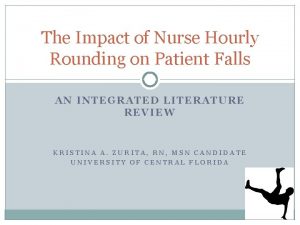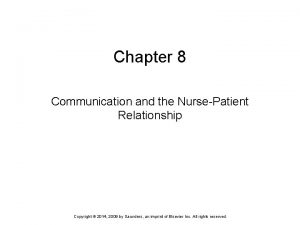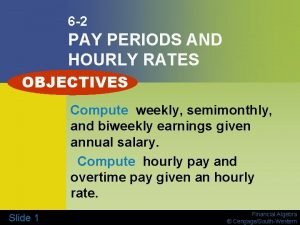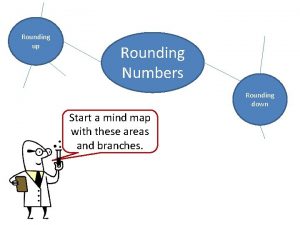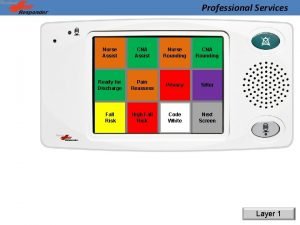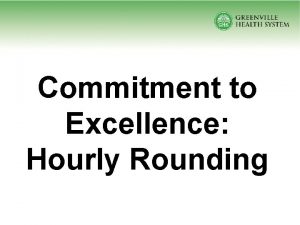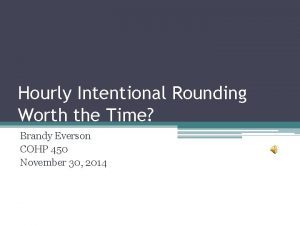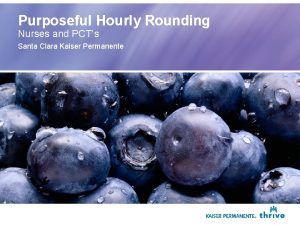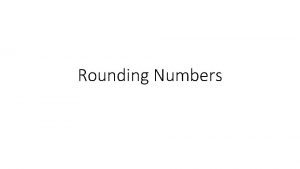The Impact of Nurse Hourly Rounding on Patient

















- Slides: 17

The Impact of Nurse Hourly Rounding on Patient Falls AN INTEGRATED LITERATURE REVIEW KRISTINA A. ZURITA, RN, MSN CANDIDATE UNIVERSITY OF CENTRAL FLORIDA

PICO Question: In the adult acute care setting, how does hourly rounding impact patient falls?

Significance and Background �Patient falls result in morbidity, mortality, and an increased fear of repeat falls �One of the most common adverse events in hospital setting �Inpatient falls range from 1. 7 to 25 falls per 1, 000 patient days �Falls can cost hospitals $5, 317 per patient fall �By 2020, patient falls are projected to cost hospitals over $54 billion in annual costs. �Since 2008, CMS no longer reimburses hospitals for patient falls (Tucker et al. , 2012; Hicks, 2015)

Significance and Background �One-third of falls are preventable (US DOH, 2015) �Majority of falls occur near the patient’s bed, in the room, or in the bathroom (Tucker et al. , 2012) �Nurses play an important role in preventing falls and maintaining patient safety (Cann & Gardner, 2011) �Reports state that hourly rounding can reduce patient falls by 50% (Hicks, 2015)

Significance and Background �Hourly rounding is the process of intentionally checking on the patient to addresses a patient’s basic needs by the nursing staff at regular intervals (Hicks, 2015) Pain management Repositioning Use of the bathroom Checking that items are within reach of the patient Assuring the patient that the nurse will return in an hour (Mitchell et al. , 2014)

Methods Databases Searched Medline Academic Search Premier Cochrane Database of Systematic Reviews Cumulative Index to Nursing and Allied Health Literature (CINAHL) Plus Search Terms Adult Acute care Hospitalization Nurse Rounding/Hourly rounding Falls/Fall prevention Patient safety

Methods Inclusion Criteria Exclusion Criteria Adult population Age groups other than the adult population Inpatient units in a hospital setting Other types of setting (ie. emergency department, outpatient units) Nurses who implemented hourly Focus on leader rounding Nurses who did not implement hourly rounding Patient safety/falls prevention was evaluated Focus on other personnel rounding

Methods �Results: 34 articles found 10 articles met inclusion criteria 2 articles were systematic reviews of non-RCT (Level II evidence) 8 articles were cohort studies or quasi-experimental studies (Level III evidence) All studies were ranked Level III for validity using the Quelly tool (2004) Total number of participants unknown due to some studies not reporting

Findings �Coding themes for hourly rounding: Decreases patient falls Increases patient satisfaction Decreases patient call light usage Proper training, implementation, and compliance is necessary for success

Findings: Decrease in falls � 9 studies showed decrease in patient falls Cann & Gardner (2012); Goldsack et al. (2015); Hicks (2015); Kessler et al. (2012); Mitchell et al (2014); Olrich et al (2012); Saleh et al. (2011); Spanaki et al (2012); Tucker et al (2012) � 2 studies showed statistically significant results Goldsack et al (2015) p=0. 006 Saleh et al. (2011) p<0. 01 � 1 study was inconclusive Krepper et al (2012)

Findings: Increase in patient satisfaction � 4 studies showed an increase in patient satisfaction Cann & Gardner (2012); Kessler et al. (2012); Olrich et al (2012); Saleh et al. (2011) � (p=0. 081; not reported; p=0. 383; p<0. 05) � 1 systematic review found 4 studies that showed statistical significance Mitchell et al (2014)

Findings: Decrease in call light usage � 3 studies showed a decrease in call light usage Krepper et al. (2012); Olrich et al (2012); Saleh et al. (2011) � (p=0. 001; number not reported; p<0. 001) � 1 systematic review found 10 studies addressing call light usage Mitchell et al (2014) � Median reduction of 54%

Findings: Proper training, implementation, and compliance needed � 4 studies discussed the importance of training, implementation, and compliance to hourly rounding Goldsack et al. 2015 Kessler et al. , 2012 Olrich et al. , 2012 Tucker et al. , 2012

Limitations �Non-randomization samples �Weak research design �Small sample sizes �Variations in the length of time �Lack of follow-up

Recommendations for Nursing �Hourly rounding should be implemented as it may: Help nurses to keep patients safe by reducing patient falls. Improve patient’s satisfaction. Decrease patient call light usage. �Proper implementation, compliance, and training of nurses should be offered to promote successful hourly rounding by decreasing patient falls. �Strength of Recommendations: A

Conclusion �Hourly rounding is an autonomous intervention that nurses can easily implement to ensure patient safety and reduce patient fall rates �Hourly rounding can also increase patient satisfaction and decrease call light usage �With proper training, nurse buy-in, and consistency to the intervention, hourly rounding can benefit both nurses and patients �Hourly rounding can help reduce unnecessary hospital costs

 Hourly rounding and patient falls
Hourly rounding and patient falls Leadership rounding
Leadership rounding Sponge nurse role
Sponge nurse role A nurse preceptor is orienting
A nurse preceptor is orienting Role of nurse in patient teaching ppt
Role of nurse in patient teaching ppt Picot question for nurse to patient ratio
Picot question for nurse to patient ratio Admission process in nursing
Admission process in nursing Nurse-patient relationship phases
Nurse-patient relationship phases Chapter 8 communication and the nurse patient relationship
Chapter 8 communication and the nurse patient relationship Phases of nurse patient relationship
Phases of nurse patient relationship The nurse has obtained the patient's oral medications
The nurse has obtained the patient's oral medications Phases of nurse-patient relationship ppt
Phases of nurse-patient relationship ppt Nurse-patient relationship phases
Nurse-patient relationship phases Patient 2 patient
Patient 2 patient Chapter 1 gross income answers
Chapter 1 gross income answers Lesson 1.1 straight time pay answers
Lesson 1.1 straight time pay answers 6-2 pay periods and hourly rates
6-2 pay periods and hourly rates Walmart pto accrual rates 2021
Walmart pto accrual rates 2021
